Huertista notes
Colima is a small state on the Pacific coast, below Jalisco. Although during the Revolution it escaped the violent upheavals experienced in some other parts of Mexico it can be seen as a microcosm for paper money, with competing factions, authorities trying to cope with the disappearance of hard currency, with counterfeiting, with ensuring a sufficient backing for any issue and with arranging a timely withdrawal.
Over time Colima used various national issues and issues from other states but also produced local solutions to the shortage of small change that impeded commerce as soon as coinage began to disappear or be hoarded. On 24 April 1914, using extraordinary powers granted him two days earlier, the interim Huertista governor, Antonio Delgadillo, authorised the State Treasury to issue a series of valesEl Estado de Colima, Tomo XLVIII, Núm. 197, 9 May 1914.
However, the matter must have been building up for some time as on 1 April the Mining Journal Press, of Mexico City, had written to Delgadillo. It said that it had learnt that the legislature had decided on an issue of bonos and wanted to be considered for the work. It enclosed examples of the notes that it had recently produced for the government of Guanajuato. The governor replied, on 13 April, that he would present their offer when the legislature passed the law authorising the issueAHEC, leg. 854. The government then received quotations from two lithographic printers, Loreto Aneira y Cía. and José M. Iguíniz. Juan Kaiser had been recommended by the Tesorero but that company did not have its own lithographers but used those of the other two printing houses.
Iguíniz included a proposed design thus:
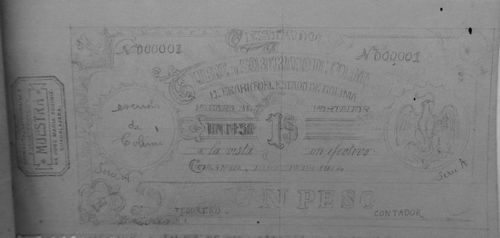
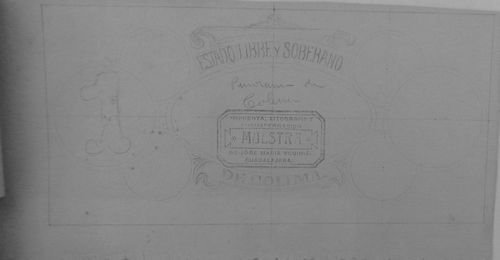
and quoted for printing 560,000 notes (400,000 of 10c, 100,000 of 20c, 40,000 of 50c and 20,000 of $1) and also for 100,000 notes (40,000 of 10c, 100,000 of 20c, 20,000 of 50c and 20,000 of $1)AHEC, leg. 849, 1914:
However, the government had difficulty in sourcing paper in the city and Delgadillo gave the contract to a company in Mexico City (see below). However, two months later they had still not arrived, so on 6 June Delgadillo authorized a provisional issue, to be printed locally and used until the definitive issue turned upEl Estado de Colima, 13 May 1914. There were a total of 100,000 pesos in four denominations – 10c, 20c, 50c and one peso – dated June 1914.
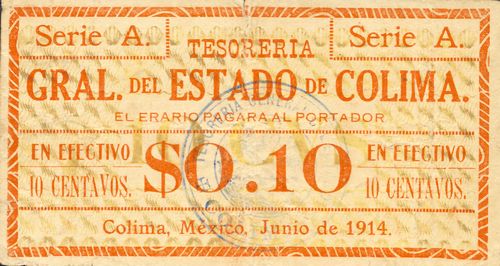
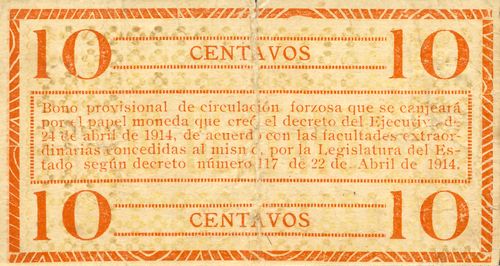
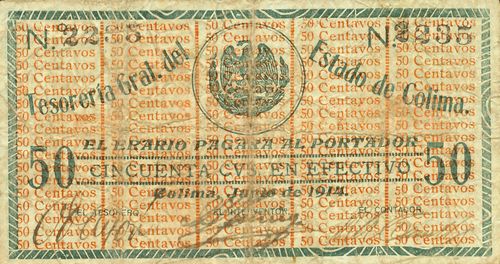
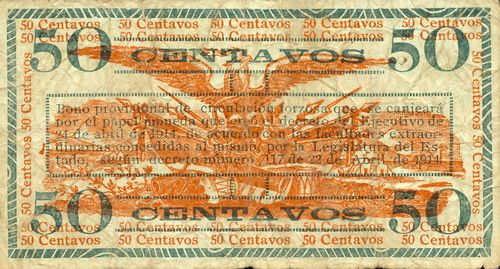
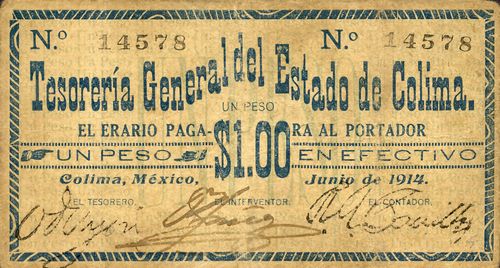
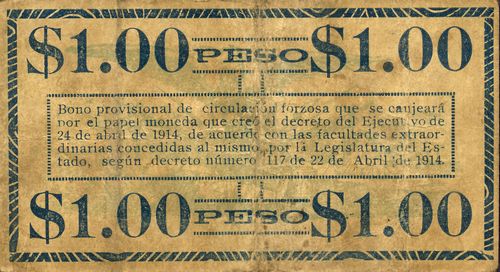
| Date of issueactually date of consignment by the Inspector de Hacienda, J. Isabel Zúñiga to the Tesorería General del Estado (AHEC, leg. 853, 1914){/footnote | Date on note | Series | from | to | total number |
total value |
||
| 10c | 4 July 1914 | June 1914 | D | unnumbered | 18,000 | 1,800 | ||
| 7 July 1914 | 18,000 | 1,800 | ||||||
| 8 July 1914 | 23,600 | 2,360 | ||||||
| 10 July 1914 | 18,000 | 1,800 | ||||||
| 11 July 1914 | 15,000 | 1,500 | ||||||
| 13 July 1914 | 13,400 | 1,340 | ||||||
| 20c | 13 July 1914 | June 1914 | C | unnumbered | 18,000 | 3,600 | ||
| 50c | June 1914 | B | 1 | 7000 | 7,000 | 3,500On 18 June Zúñiga authorised the payment to someone who had, to date, numbered 12.000 notes, which will have been 11,000 50c and 1,000 $1 notes (AHEC, leg. 852, 1914) | includes number 2235 | |
| 18 June 1914 | 7001 | 10000 | 3,000 | 1,500 | ||||
| 19 June 1914 | 10001 | 11000 | 1,000 | 500 | ||||
| 20 June 1914 | 11001 | 15000 | 4,000 | 2.000 | includes number 11561 | |||
| 21 June 1914 | 15001 | 16000 | 1,000 | 500 | ||||
| 28 June 1914 | 16001 | 17000 | 1,000 | 500 | ||||
| $1 | 21 June 1914 | June 1914 | A | 1 | 1000 | 1,000 | 1,000 | |
| 22 June 1914 | 1001 | 4000 | 3,000 | 3,000 | ||||
| 23 June 1914 | 4001 | 6000 | 2,000 | 2,000 | ||||
| 24 June 1914 | 6001 | 9000 | 3,000 | 3,000 | ||||
| 25 June 1914 | 9001 | 11000 | 2,000 | 2,000 | ||||
| 26 June 1914 | 11001 | 14000 | 3,000 | 3,000 | ||||
| 27 June 1914 | 14001 | 15000 | 1,000 | 1,000 | ||||
| 26 June 1914 | 15001 | 18000 | 3,000 | 3,000 | ||||
| 29 June 1914 | 18001 | 26000 | 8,000 | 8,000 | ||||
| 30 June 1914 | 26001 | 31000 | 5,000 | 5,000 | ||||
| 1 July 1914 | 31001 | 36000 | 5,000 | 5,000 | includes numbers to 35013CNBanxico #166 | |||
| 2 July 1914 | 36001 | 40000 | 4,000 | 4,000 | ||||
The recorded consignments total $62,700 (106,000 10c, 18,000 20c, 17,000 50c and 40,000 $1). It is unknown whether this was the total issue. Delgadillo’s authorisation was for $100,000 but he was forced out of Colima in mid-July.
These unsurprisingly have a makeshift, military appearance, and could be considered as similar to the more well-known Huertista “siege” issues of Monterrey, Saltillo and Guaymas. The higher values were signed by Odilón Ayón as Treasurer (Tesorero), J. Isabel Zúñiga as Interventor and Ramón A. Carrillo as Accountant (Contador).
|
Odilón Ayón was made Tesorero General on 5 January 1914Estado de Colima, Tomo XLVIII, Núm. 5, 31 January 1914. He was Administrador Principal de Rentas on 28 April 1914El Estado de Colima, 2 May 1914. |
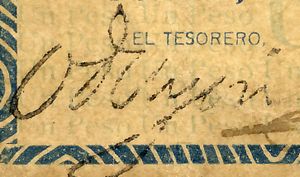 |
|
J. Isabel Zúñiga was already serving as Visitador de Hacienda when, on 10 June, Delgadillo appointed him Interventor to oversee the issue of these bonosAHEC, leg. 852, 1914. |
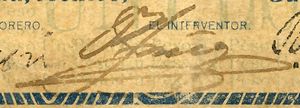 |
| Ramón A. Carrillo | 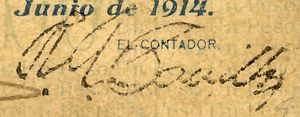 |
The Constitutionalists under General Alvaro Obregón captured Colima on 19 July 1914 and a week later Obregón banned Delgadillo’s notesEl Estado de Colima, Tomo XLVIII, Núm. 27, 25 July 1914). Though Delgadillo’s notes had been banned they still needed to be withdrawn, so on 4 August the State Treasurer, Ramón A. Carillo, announced that businesses and individuals who held more than fifty pesos in these notes had a week to hand them into the General Treasury in exchange for special certificatesEl Estado de Colima, Tomo XLVIII, Núm. 28, 1 August 1914.
The government continued changing large quantities of Delgadillo’s notes in the Tesorería General del Estado, mainly for the benefit of the poorEl Popular, Colima, Epoca Tercera, Núm. 62, 24 September 1914. However, on 26 September 1914, interim governor Ignacio Padilla told the Treasury only to change notes for holders who were completely destituteEl Popular, Epoca Tercera, Núm. 64, 26 September 1914.
On 14 October the Tesorero Municipal of Colima reported that he had $1,570.90 in his office that needed to be changedAMCol, Actas de Cabildo, Colima, libro 87, acta 39, fojas 101v-103v. The Secretario General told the Tesorería General to exchange them in early DecemberAMCol, Actas de Cabildo, Colima, libro 87, acta 48, fojas 120f-122f: AMCol, E-59, Pos. 20, Exp. 259.
A counterfeit note?
On 29 June 1914 an apprentice at the government printing press, J. Jesús Martínez, was imprisoned under the suspicion of having circulated a bono falso. On 10 July his mother, Severa González, wrote to the governor that her son hardly knew how to read or write, which was why he had made so little progress in his two years at the printers. If one compared her son’s writing with that of the counterfeit bono one would see that he was not responsible as the latter was the work of someone who knew how to write. She asked that he be set free, but on 16 July the governor replied that the investigation had to take its courseAHEC, leg. 852, 1914.
Notes printed in Mexico City
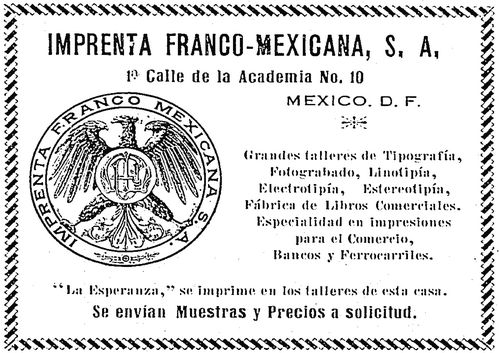
So, what happened to Delgadillo's original printing? The answer is provided by two notes, a 50c and $1, printed by the Imprenta Franco Mexicana, a book-printer in Mexico City. Though these are of a reasonable quality, they are a simple design, with vignettes of the national emblem, the state’s coat of arms and a view of the nearby active Vólcan de Colima, and lack the sophistication of normal bank-notes. They fulfill the specifications of the original 24 April decree, namely:
1. four values, divided into distinct series ($1 –Serie A, 50c – Serie B, 20c – Serie C and 10c –Serie D)
2. issued by the Tesorería General (Erario) del Estado, and
3. to be signed by the Tesorero and Contador.
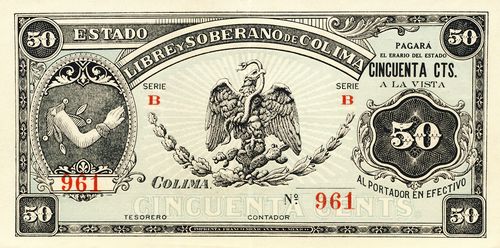
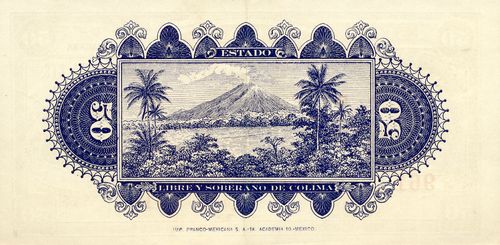
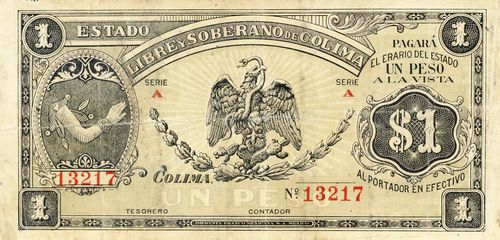
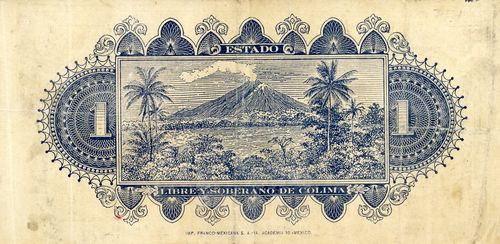
| Series | from | to | total number |
total value | ||
| 10c | D | 400,000 | $ 40,000 | |||
| 20c | C | 100,000 | 20,000 | |||
| 50c | B | 40,000 | 20,000 | includes numbers 961CNBanxico #154 to 7181 | ||
| $1 | A | 20,000 | 20,000 | includes numbers 129 to 39867 | ||
| $100,000 |
They were printed by a Mexico City firm, unaccustomed to such work and unable to complete on time, and some of these unissued, unsigned and unsealed notes survived as curiosities, though the two lower values have not been recorded.
